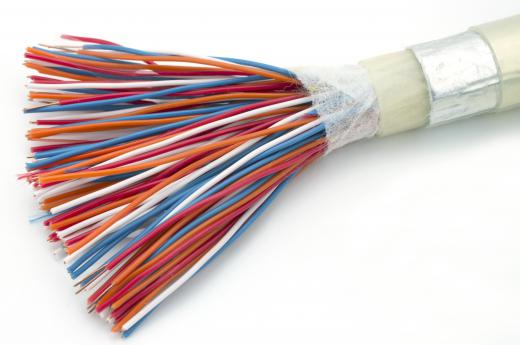A cable sheath wraps around the outside of a cable to hold and protect the conductors on the inside. Sheaths are used in cabling for electricity transmission, telecommunications, and other purposes. A variety of types are available to handle varying voltages and settings. These include heavy-duty sheathing for high voltage power lines as well as lightweight products to handle inside phone wiring for homes and other structures. Manufacturers of cables may produce their own sheathing or contract it out to another firm that specializes in insulation supplies.
One function of a sheath is to help bundle the conductors together if there are multiple wires inside a cable. The cavity inside can also be filled with lubrication or insulation to protect the conductors. Rain, snow, and other environmental hazards are unable to enter cable with intact sheathing, which reduces the risk of shorts and other problems. A cable sheath also protects passerby and workers by limiting the chance of direct contact with an energized cable.

Sheathing can include one or more layers of insulating material and weatherproofing. Considerations in sheath design include the amount of energy the cable carries and where it will be used. Heavy insulation may be needed for potentially dangerous settings, like outdoor environments and power plants with high energy wiring. This type of cable sheath would be excessive for a setting like home speaker wire, which doesn’t carry enough energy to pose a significant risk and is used in a relatively tame indoor environment.

Over time, a cable sheath can crack. This may be the result of weathering as well as strain; cables can blow in the wind and develop creases, for example, or eventually degrade with constant ultraviolet or salt exposure. Fault checkers can locate cracks and determine if the cable inside is damaged. It may be possible to use a repair kit to fix the sheath, while in other cases, lengths of cable need to be replaced because they are faulty.
Technicians also need to be able to cut into a cable sheath for splices, repairs, and other activities. They use specialized tools capable of cutting through thick materials so they can quickly pull away the outer layers of sheathing and insulation to access the inside of the cable. For safety, the tool may have a nonconductive handle in case the cable is energized while the technician works on it. Such tools are available from industrial electrical suppliers and similar companies.
Ever since she began contributing to the site several years ago, Mary has embraced the exciting challenge of being a About Mechanics researcher and writer. Mary has a liberal arts degree from Goddard College and spends her free time reading, cooking, and exploring the great outdoors.

